2007 VOLKSWAGEN JETTA towing
[x] Cancel search: towingPage 100 of 477
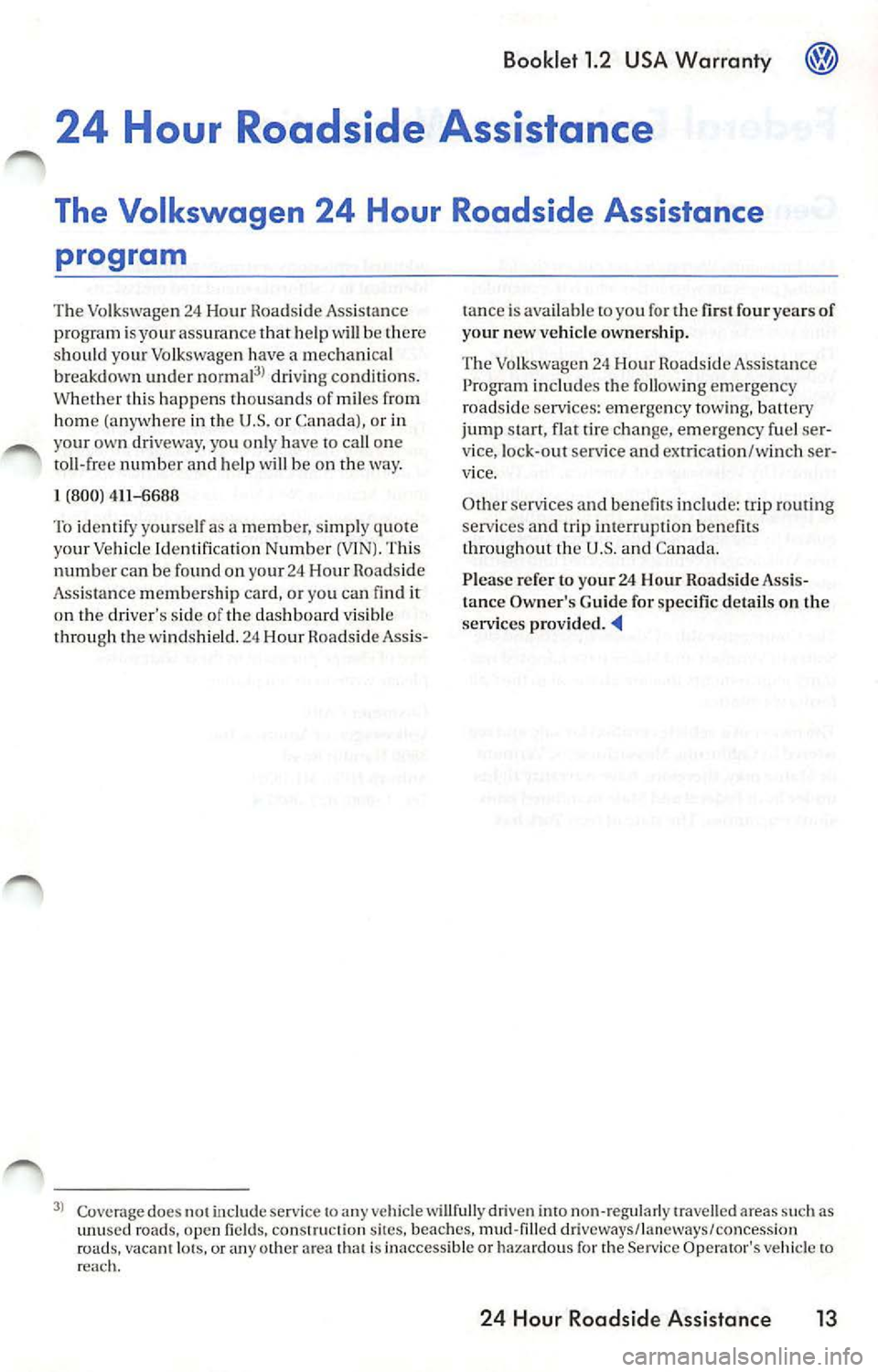
Booklet 1.2 USA Warranty
24 Hour Roadside Assistance
The Volkswagen 24 Hour Roadside Assistance program
T he Vo lk sw age n 24 Hour Road sid e Assistance
p rogram is you r assurance that help will be ther e
s hould your Volk swagen have a m echani cal
breakdown under
dri vin g condit ions.
Whe ther thi s happens thousand s of mil es fro m
hom e (anyw here in th e U.S . or
or in
yo ur ow n dr iveway , yo u onl y have to call one
toll-fr ee numb er and help will be on the w ay.
l (8 00 ) 411-6688
To identify you rse lf as a m emb er, simp ly quo te
y our V ehi cle Identific atio n Number (VIN ). T his
number can be fo und on your 24 Hour R oadsid e
Ass is tan ce mem ber ship card , o r you ca n find it
on t he driver's sid e of th e dashboard vis ibl e
t h rough the wind shi eld. 24 Hour Roa dside Ass is- tan
ce is availabl e
to you for the first four years of
your new ve hicle ow ners hip.
T he Volkswage n 24 Hou r Ro ad sid e Ass is tan ce
Program includ es th e fo llow ing em ergency
roa dside services: emergency towing, battery
jump start, flat tire chan ge, emergency fuel ser
vice, loc k-o ut ser vice and extr ica tion/ winch ser
v ice.
Other services and b en efit s includ e: trip routing
an d trip interruption b enefits
th roughout the U.S . a nd Canada.
Please refer to you r 24 Hour Roads ide A ss is
tanc e Owner's Guide for
details on the
serv ices provided.
Coverage does not incl ude service 10 an y ve hicle willfully dr ive n no n-regularly travelled areas suc h as
unu sed roads, open field s, construct ion sit es, beac hes , mud -filled dr ivcw ays/lan cways/co nces sion
road s, vacan t lo ts, or any other
1h a1 is inacces sible o r hazardo us fo r th e Se rv ice Operator's vehicl e 10 reach .
24 Hour Roadside Assistance 13
Page 133 of 477
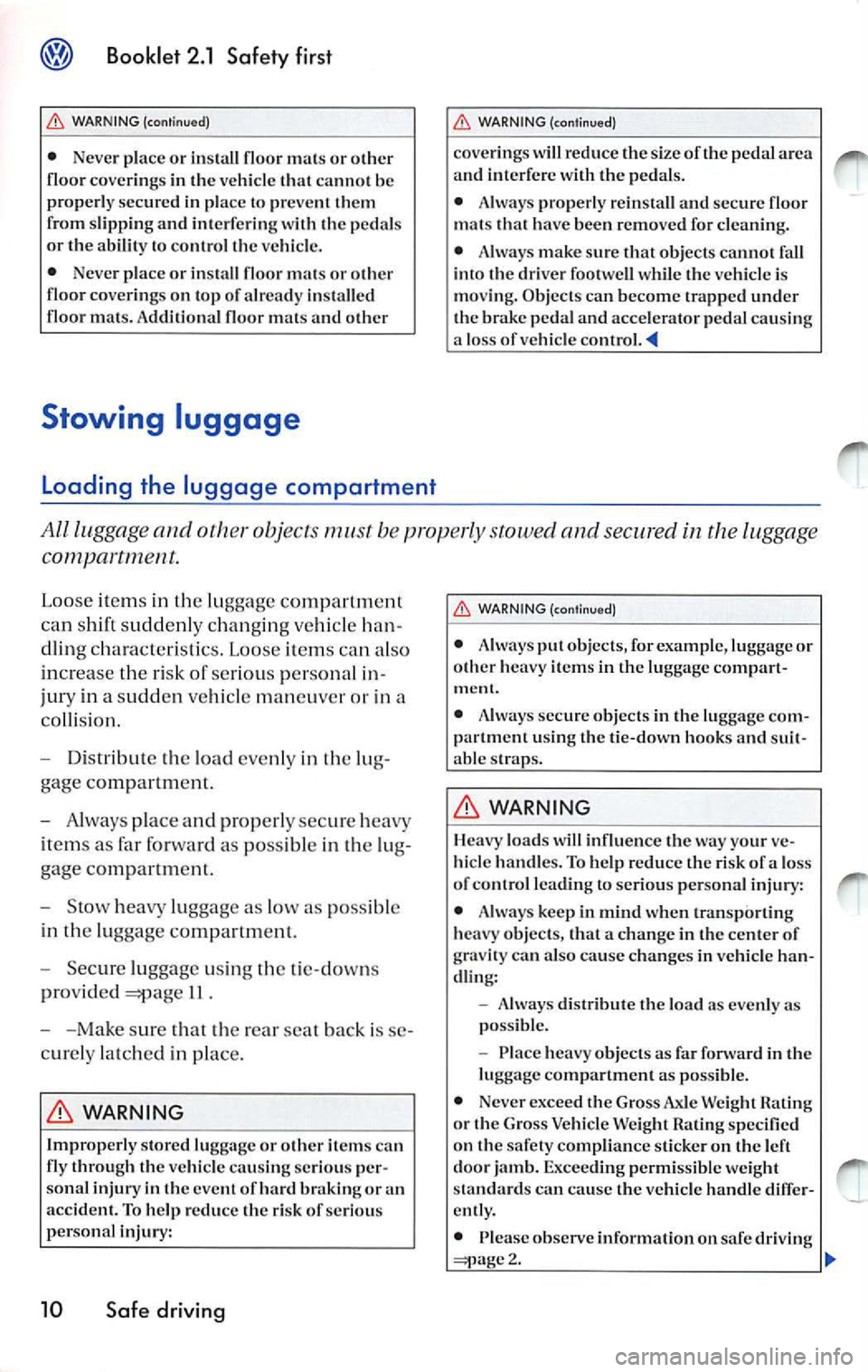
Booklet 2.1 Safety first
WARNING (conlinuod)
• Neve r place or install floor mats or other
floor cover ings in th e vehicle that can n ot be
proper ly secure d in place to prevent them
from slip pin g and
with the pedals
or the abili ty to contro l the vehicle.
• Neve r place or insta ll floor mats or o ther
floor coverings on top of alr eady ins ta ll ed
floor mats. Additiona l floor mat s and oth er
Stowing luggage
Loading the luggage compartment
WARN ING (con tinued)
coverings w ill reduce the size of the pedal area
an d int erf ere with the pedals.
• Always properly reinstall and sec ure floor
ma ts that have been removed for cleaning.
• Always make sure that objects can not fa ll
int o the driver foot well w hile th e vehicle is
moving. Objects ca n become trapped under
th e brake pedal and acce lerator peda l ca using
a loss of vehicl e
All luggag e and object s ,n ust b e prop erly stowed and secured the luggage
compartment.
Loos e item s in th e luggag e compartmen t
c an shi ft sudden ly chang ing vehicle han
dling charact eri stic s. Lo ose item s ca n also
in crea se the ri sk of se ri ous pe rs onal in
j ur y in a sudd en veh icl e m an euv er or in a
co llision.
- Distribute the load evenly in th e lu g
gag e compar tment .
- Alwa ys pla c e and properly sec ure heav y
it em s as far forward a s po ss ibl e in the lug
gage compar tm ent.
- S tow hea vy lugg age as low as possibl e
in the luggag e compar tm ent.
- Secure luggag e usin g th e tic -dow ns
pro vid ed
11 .
- -Ma ke su re that the re ar sea t ba ck is se
cu re ly lat ch ed in pl ace.
WARNING
Improp erl y s tor ed luggage or other items can
fly through the vehicl e cau sing serious per
so nal inju ry in th e event of hard braking or an
accident. To help reduce the risk of se rious
personal injury:
10 Safe driving
WARN ING (continued)
• Always put objects, for examp le, luggage o r
oth er he avy item s in the luggage compa rt-
WARNING
Heavy loads will influ ence the way yo ur ve
hicle handle s. To help reduce the risk of a lo ss
of contro l lea din g to serio us personal injury:
• Alway s keep in mind when t ransporting
h ea vy objects, that a c hange in the ce nter of
grav ity can also ca use c hang es in ve hicle han
d lin g:
- Always distribut e the load as eve nly as
po ss ibl e.
- Place heavy objects as far forward in the
luggage compart ment as poss ible .
• Never excee d the Gross Axle Weig ht Rating
or the Gross Vehicle Weight Rating specified
on the safety complian ce s ticke r on the lef t
door jamb. Exceed ing permissib le we ig ht
s tandards can cause the vehicl e handl e diff er
e ntl y.
• Please observe information on safe driv ing
Page 331 of 477
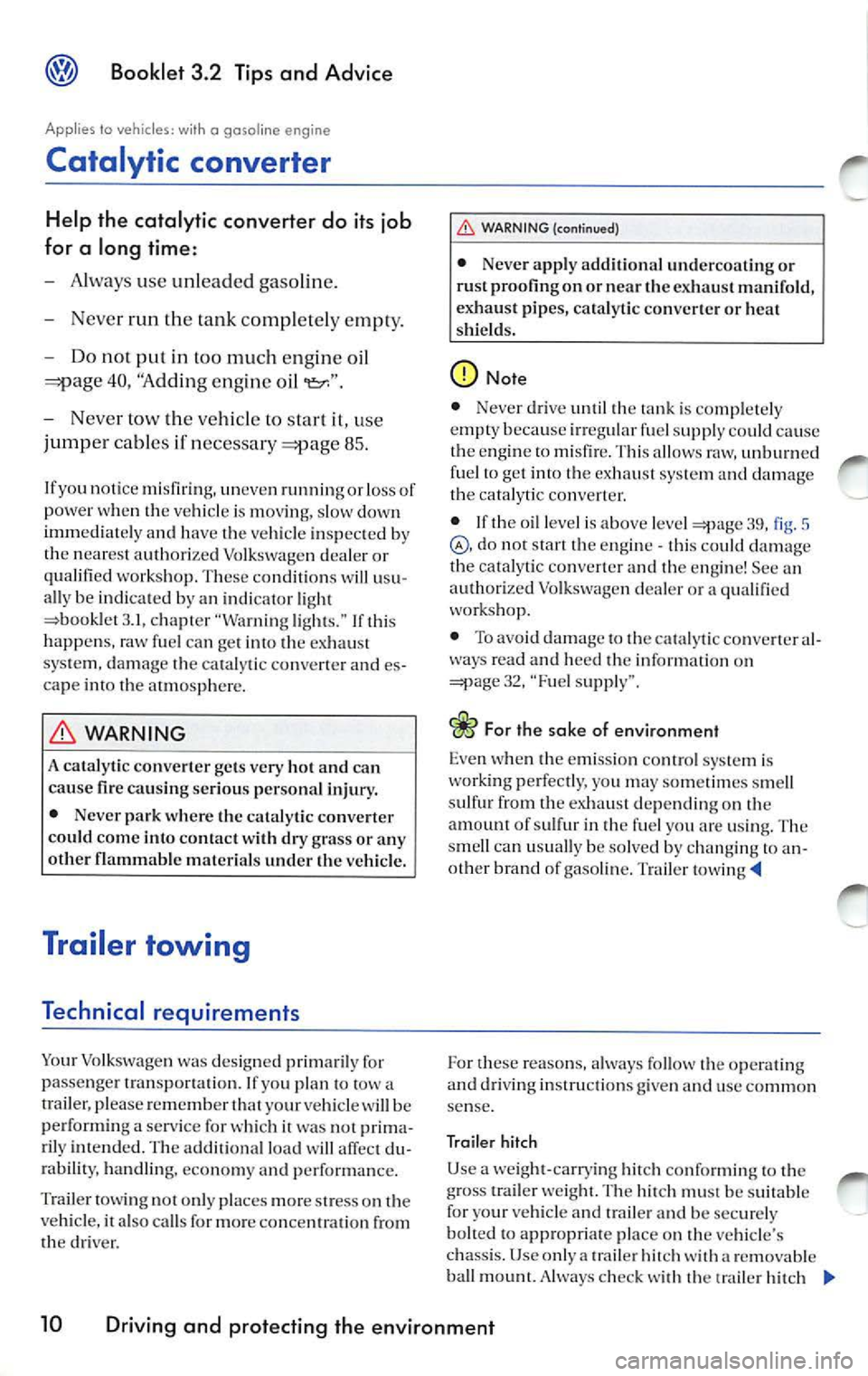
Booklet 3.2 Tips and Advice
Applies to veh icles: with o gaso line engi ne
Catalytic converter
Help the catalytic converter do its job
for a long time :
-Alwa ys use unl eaded gasol ine.
- Never
the ta nk complet ely empty .
- Do not put in too much en gin e oil
40, "Adding engine oil
-Never tow the ve hicle to start it, use
jump er cab les if n ecess ary
85.
If yo u notic e mi sfiring, uneve n runn ing or loss of
power w hen th e vehicl e is m ov ing , s low down
immediate ly and h ave the vehicl e in sp ec te d by
th e nea res t a uth oriz ed Volk swagen deal er or
qu alifi ed wo rksh op. These co nditions w ill u su
a ll y be in dic ated b y an ind icator light
3. 1, chapt er "Warning light s." If thi s
happ ens, raw f uel ca n ge t int o th e ex hau st
sys te m , d am age t he ca ta ly ti c co nverte r and es
ca pe int o th e atmosp here .
WARNING
A ca ta ly tic conver te r get s very hot and can
cau se lir e ca usin g se riou s personal injury.
• Neve r park where th e cata lytic converter
co uld come into conta ct with dry grass o r any
other flammabl e materials under the vehicl e.
Trailer towing
Technical requirements
Yo ur Volk sw agen was desig ned primaril y for
pas seng er tr an spor ta ti on. If yo u plan to
trai ler , plea se re m emb er th at yo ur ve hicle w ill be
p erformin g a serv ice for whi ch it w as not prim a
ril y in ten ded. The addit io na l lo ad will affec t du
r ability, hand lin g, econ omy and p erfor mance.
Tra iler to wing not only pl aces more s tress on the
ve hicle, it a lso calls for mor e co nce ntrati on from
t h e dr ive r.
WARNING (continued)
• Never appl y additional under coating or
ru st proofin g on or near the ex haus t manifold ,
exhaust pipes, ca ta ly tic conver te r or hea t
s hi elds.
39 , fig . 5 d o not sta rt the e ngi ne thi s co uld dama ge
the catalyt ic c onverter and the e ngin e! See an
a uthori zed Vo lkswage n dea le r or a qualifi ed
works hop.
• To avoi d dama ge to th e ca talyti c conve rter al
ways rea d and hee d th e in formation on
=:page 32, "Fu el suppl y".
For the sake of environment
Even when th e e missio n co ntro l syste m is
worki ng perf ec tly, yo u may so metim es s mell
s ulfur from th e ex hau st d ep endin g on th e
a m ount of sulf ur in th e fu el you arc usi ng. T he
s m ell ca n usua lly be so lved by ch angin g to an
ot her brand of ga solin e. T railer
For th ese reason s, a lwa ys fo llow the o pera tin g
an d dri vi ng in stru ction s given a nd use comm on
se nse.
T railer hitch
U se a we ig ht -carry ing hitch co n fo rm ing
trail er hit ch re movab le
ball mount. ch eck with th e traile r hit ch
10 Driving and protecting the environment
Page 333 of 477
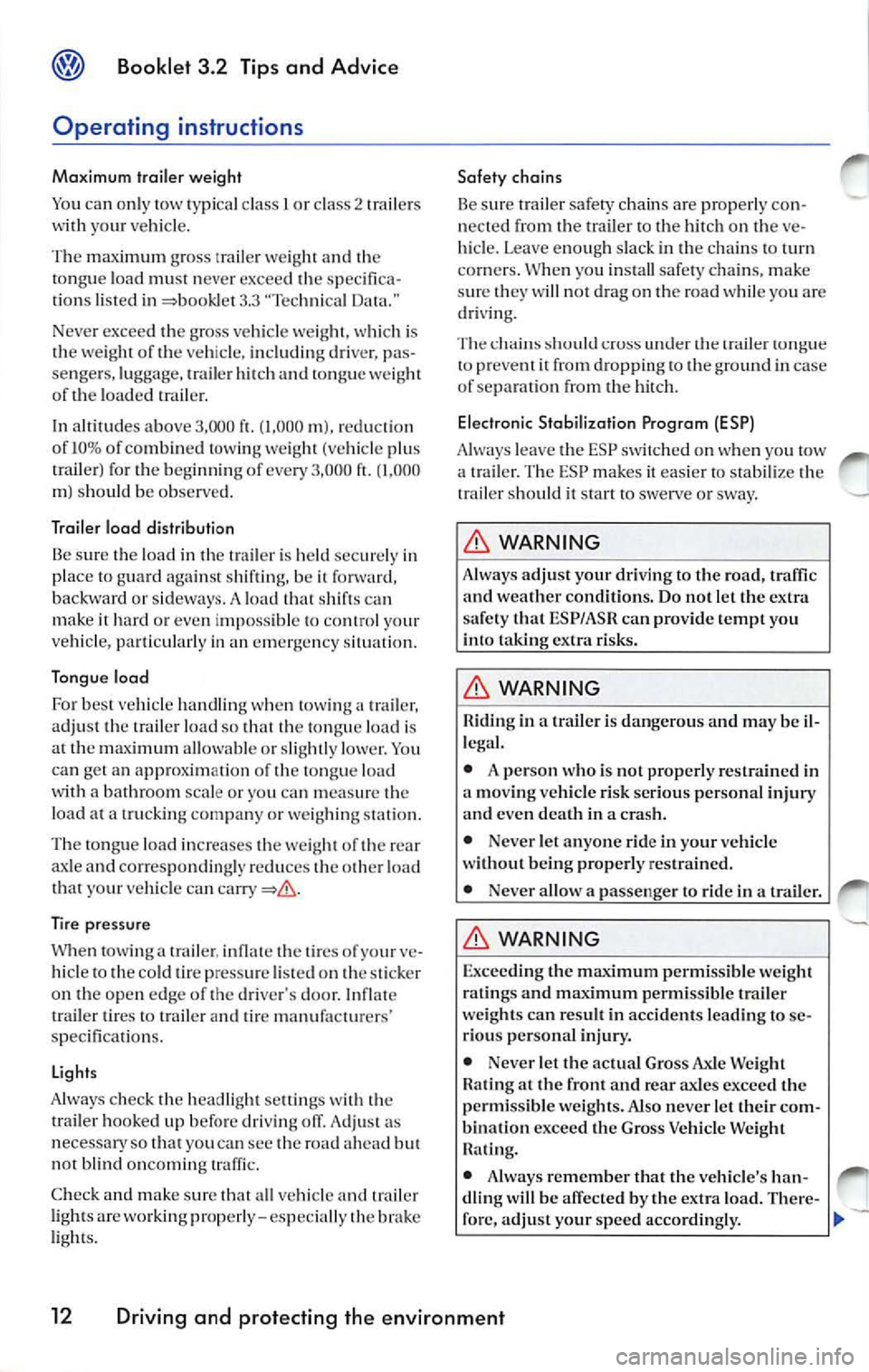
Booklet 3.2 Tip s and Advice
Operating instructions
Maximum trail er weight
Yo u ca n onl y tow 1y p ic al clas s I o r cla ss 2
I railers
w ith your vehicle.
T he m ax imum gross trailer weigh1 and 1h e
tongue loa d mu sl never exceed 1he s pecifica
tion s liste d in
3.3 "T ec hni cal
Neve r ex cee d 1h e gro ss v ehicle weigh 1, w hich i s
th e we ight of 1 he veh icle. includin g driv er, pa s
se nge rs , lu ggage,
I raile r hi1 ch an d 1ongue wei gh I of t he loa ded trailer.
I n alt itude s abov e
3,000 f1. (1,000 redu ctio n
of 10% of co m bin ed lowing weight (v eh icle plu s
trai le r) fo r the beginn ing of every
3, 000 f1. (1,000 m ) shou ld be obser ved.
Trailer loa d distribution
sur e th e loa d in th e tra il e r is held secu rely in
plac e to gu ard against shif ting, b e ii forward ,
ba ckward or sidew ays. A load that shifl s can
mak e it hard or eve n imp ossib le 10 co n1rol your
ve hicl e, pa rticul arl y in an emergency s ituat ion.
Tongue load
F o r best ve hicl e handling when towing a tra iler,
adju st th e traile r load so
the tongue lo ad i s
at the maximum allow abl e or slightl y lo w er. You
ca n get an approxim ation o f th e tongu e load
wit h a bathroom scale or yo u can m ea sure the
load at a 1 rucking com pany or weig hing stat io n.
Th e to ngue lo ad in cre ases the we ig h t of t he rear
ax le and corres po ndingl y re du ces the oth er l oa d
that your vehicl e ca n
pressure
towing a trailer, inflat e th e tir es o fyourv e
hicle to th e co ld tir e pre ss ure liste d on th e stic ker
on th e op en edg e of the dr ive r's door . Inflat e
tra iler tires to traile r and tire
s p ec ification s.
Light s
Al way s che ck th e head lig ht se 1tin gs wit h th e
tra iler hooked up befo re dri vin g off. A djust a s
n ecessary so
you can see th e road ahead but
n ot b lind oncom ing traffic .
C hec k and make sur e tha t all vehicl e and
light s are wo rki ng properl y-esp ec iall y the light s. S
af ety chains
sur e tr ailer safet y cha ins are properl y co n
n ect ed from t he tra iler to the hi tch on th e ve
h icl e. Leave e nou gh slack in the c hain s 10 turn
co rner s. Whe n yo u in s1a ll safery cha ins, m ake
s ur e th ey will not drag o n the road w hile you are
d ri vin g.
T he chains shuultl
u ntler t he traile r to prevent it from dropping to th e grou nd in cas e
of sepa rat ion from the hitch.
Electronic Stabilizat ion Program (ESP )
A lwa ys leave th e ES P swi1ched on w hen you tow
a trail er. The ES P makes it easi er to stab ilize the
trailer sh ould it start to swerve o r sw ay.
WARNING
A lways adjust your dri ving lo th e road, traffi c
and weather condition s. Do not let the extra
s af ety that ESP/AS R can provid e te mpi you
i nto laking extra risks.
WARNING
Ridin g in a trail er i s da ng erous and may be il
leg al.
• A person who is not properly re str ain ed in
a m ov ing ve hicle ri sk ser iou s perso nal inju ry
a nd even death in a cras h.
• Nev er let anyone rid e in your vehicle
witho ut bein g prop erly restr ain ed.
• Never all ow
pa ssenger lo ride in trailer .
WARNING
Exceeding th e permi ssible weig ht
rat ings and permis sible trail er
we ig ht s ca n result in accident s leadi ng to se
r ious persona l injury.
• Neve r le t th e ac tual Gross Axle Weight
Ratin g at th e front and rear
exceed the
pe rmi ssibl e we ig ht s. Also neve r le t th eir com
b in atio n excee d th e Gross Vehicle Weig ht
Ra ting.
• Alw ays re member that the vehicle' s han
dli ng will be
by the extra load. There-
fo re, adju st yo ur spee d accordin gly .
12 Driving and protecting the environment
Page 334 of 477

WARN ING (continu ed)
• Exceed ing permi ssibl e weig ht ratings can
r es ult in ve hicl e da m age, accide nts, and per
sona l
Driving tips
For th e best handlin g of ve hicle and trailer,
p lease note th e fo llowing:
• A "bala nce d" rig is easie r
operate and con
trol. This m ean s th a t th e tow vehicl e should b e
loaded to th e extent p ossible and p ermi ssible
whil e keep ing th e trailer as light as po ssibl e
und er th e circum stanc es. Wh eneve r po ssib le,
tran sfe r som e cargo to the
co mpar tment
of the tow vehicl e w hile obs ervin g tongu e loa d
req uirem ents and vehicle loa ding consid er
a tion s.
• The high er th e s pee d, the more
it be
come s fo r the drive r to control th e rig. Do not
dr ive at the maximum permis sibl e
• Always appl y br akes earl y. When driving
d ow nhill, d ownshi ft into a lower gear to u se the
e ng in e brak in g eff ec t to slo w down the ve hicle.
U se of the brake s alo ne ca n ca use them to ove r
h ea t an d fail.
• The coo ling effect of the rad iator fan cann ot
b e in crease d by dow nsh ifti ng beca use fan sp ee d
i s ind epend ent of engine sp ee d. The re for e,
Trailer towing tips
Your vehicle handles diff ere nt ly wh en t ow in g a
t ra iler b ecause of the a ddit io na l weight and
weig ht d is tribut ion. S af ety. perform ance and
e conomy will gr ea tly depend on how car efull y
yo u load your tra iler
yo ur rig.
B efor e y ou actua lly
your tra iler, practice
t urn ing. stoppin g and backing up in an ar ea
away from
until yo u l earn the feel of your
ve hicle and trailer unit.
Backing up is
r e quir es prac tice .
S teer ing w hile backing up is generall y opposite
of th at wh en backing your vehicl e w ith out a
tra iler.
Booklet 3.2 Tip s and Advice
wh en dr iving uphill , yo u can alwa ys dri ve in the
hi gh est po ssible gea r wit h low e ngin e sp ee d. If
th e coo lant te mp erature warning light in the in
s trument cluste r start s fla shin g in red , p ull off
the road , stop and le t th e e ngin e id le for abou t
minute s to pre vent hea t bu ildup and engin e
damag e.
WARNING
• Reduce you r speed even more under unfa
vora ble load, wea ther or w ind condi tions
p artic ular ly w hen goi ng dow nhill.
• Be especia lly carefu l w hen passing o ther
veh icles. Redu ce ve hicle sp eed immediate ly if
the tra iler sh ow s the sli ghtest sig n of sway ing.
• Neve r try to stop the sway ing by acceler
ating.
• Always heed speed lim its. In some a reas
speed lim its for vehicl es tow ing tra ilers are
l ower than for reg ular
Keep more di stan ce between your vehicl e and
th e one in front of you. will nee d m ore roo m
to stop.
To compens ate fo r th e traile r, yo u w ill n eed a
l a rger than normal tu rning
When passing , reme mber that you can not acce l
erate as fast as you normall y wou ld because of
t h e added load. Make sur e yo u ha ve enough
room to pas s. After passing, allow plen ty of room
fo r yo ur tr aile r befor e changing la nes aga in.
Avoid jerk y s tart s, sharp turns or rapid lan e
c h ange s.
Driving and protecting the env ironment 13
Page 380 of 477
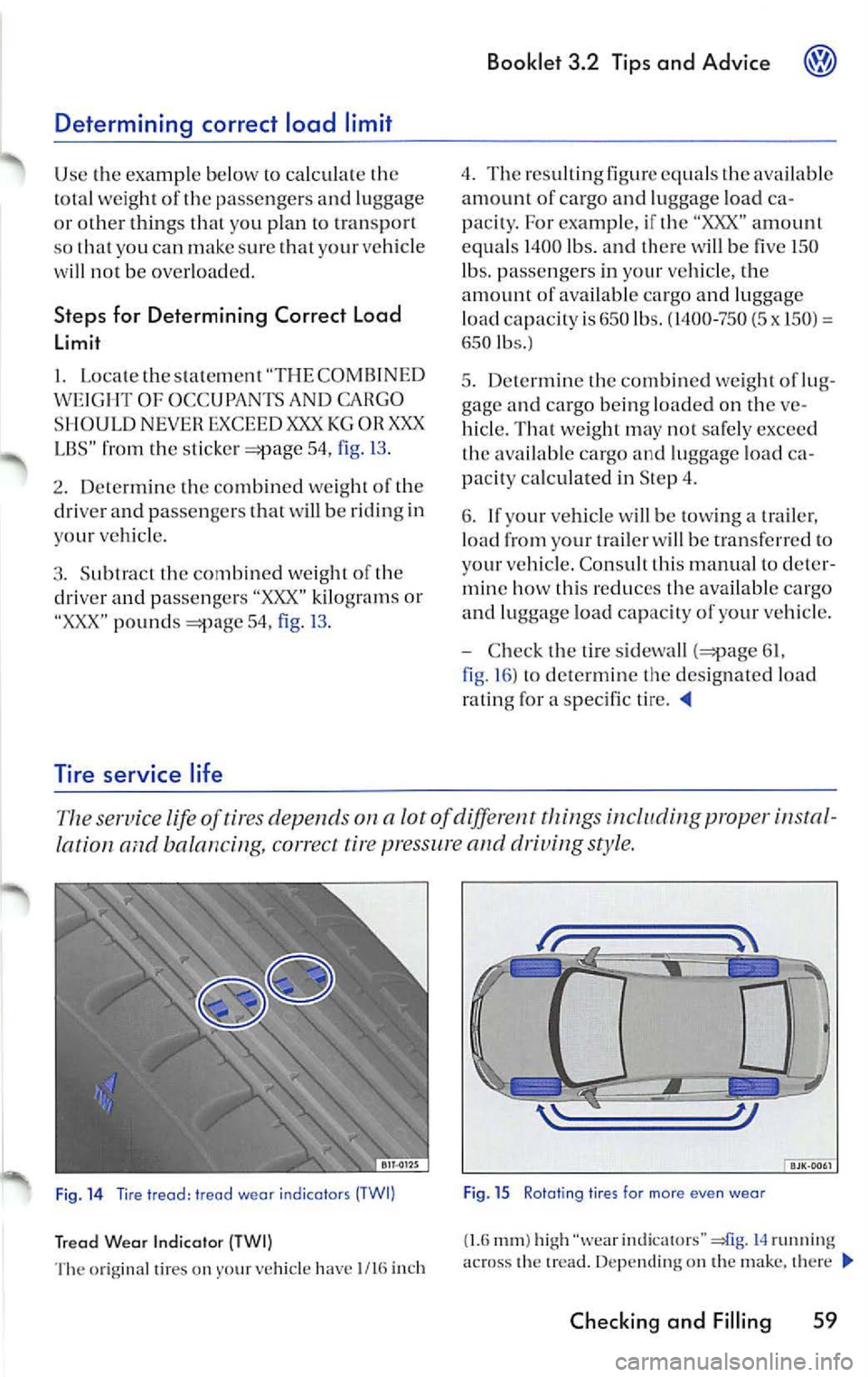
Determining correct load limit
Use the examp le below to calcula te the
total weigh t of the pa sse ngers and luggage
o r ot her thing s that you plan to transport
so that you can make s ure that your vehicl e
w ill not be overload ed .
Steps for Determining Correct Load
Limit
I. Locate the sta te m en t "TH E COMBIN ED
WE IG HT OF OCC UPA NTS AND CARGO
S HOULD NEVER EXCEED
XXX KG OR XXX
LB S" from the st ic ker
54, fi g. 13 .
2. Determine the combined weig ht of the
d ri ve r and passen gers chac w ill be riding in
your ve hicle.
3 . S ubtract the combined weight of the
driver and passengers "XXX" kilograms or
"XXX" po unds
4. Th e re sultin g figu re equa ls the ava ilab le
amount of cargo and luggage load ca
paci ty.
ex ample , if th e "XXX " am ou nt
equa ls
1400 lbs . and there w ill b e five 150
lb s. passengers in your vehicle , th e
amount of avai lab le ca rgo and luggage
lo ad capac ity is
650 lb s. (14 00- 750 ( 5 x 15 0 )
650 lb s.)
5. Determine the combined we ight of lu g
gag e and ca rgo bein g load ed on the ve
hicl e. Th at we ight may no t sa fely excee d
the ava ilable cargo and luggag e load ca
pa cit y ca lc ulat ed in Step
4.
6. your ve hicle will be towing a trailer,
load from your trailer will be transferred to
yo ur vehicle. Consult thi s manual to d eter
mine ho w this re d uces the ava ilable carg o
a n d luggage load capacit y of your vehicle.
- C heck the ti re sid ew all
fig. 16 ) to de te rmin e the de signated load
ratin g for a spec ific tire.
se rvice lif e of tires depend s on a lot of diffe rent inc/11di11g proper instal
balanc ing, correc t tir e pressu re and driv ing style .
Fig. 14 Tire tread: tr ead wear ind icators (TW I)
Tread Wear Indicator {TWI)
Th e ori gina l ti re s on yo ur veh icle have I /16 in ch
Fi g. 15 Rotating t ires for more even we ar
(1. 6 mm ) hi gh indi cator s" 14 runn in g
a cro ss the Depending on th e m ak e, th ere
Checking and Filling 59
Page 391 of 477
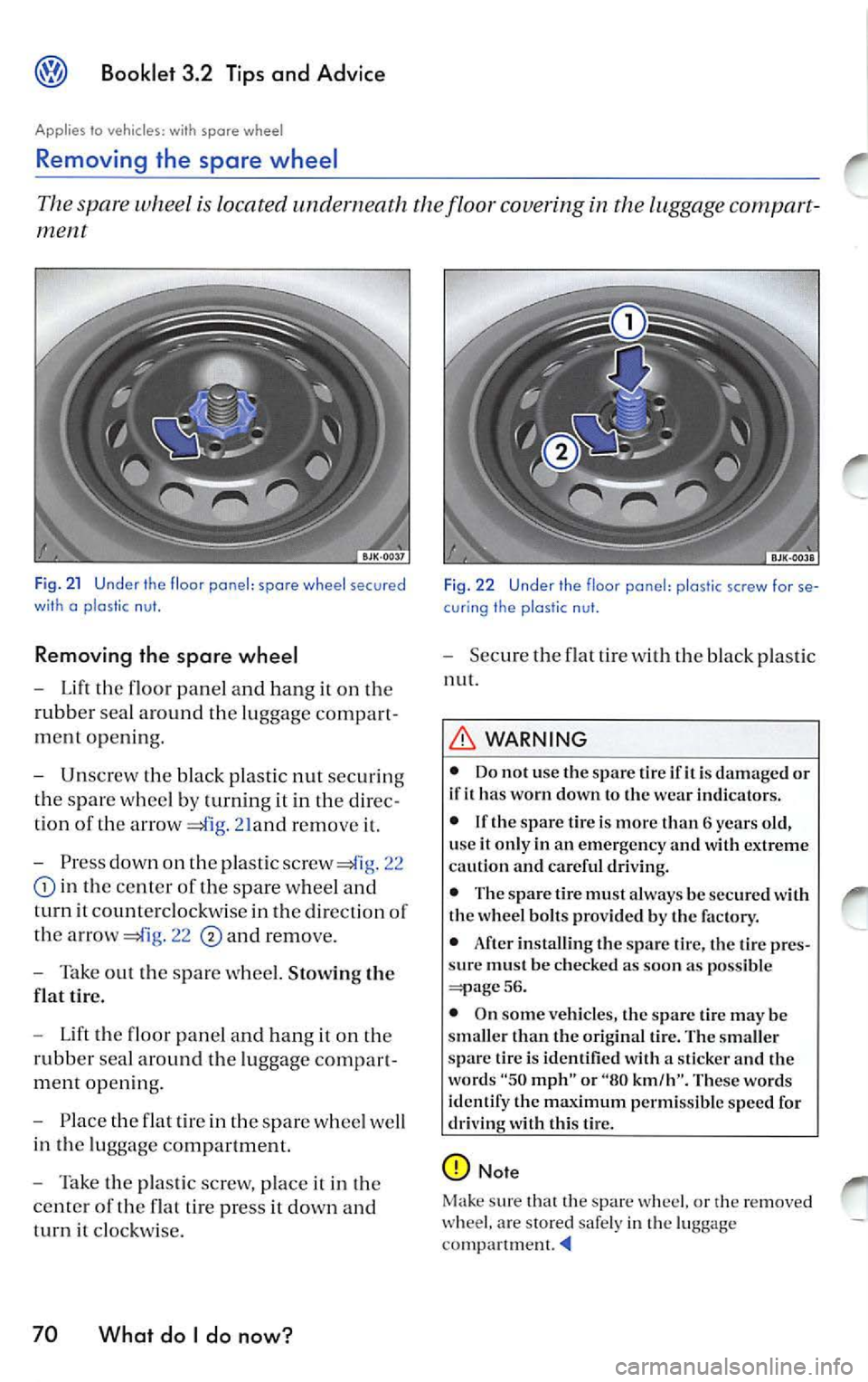
Booklet 3.2 Tips and Advice
Applies lo vehicles: wi th spore whee l
Removing the spare wheel
The spar e wheel is located und ern eath the floor covering in the luggag e compart
Fig. 21 Under th e floor ponel: spore wheel secured
wi th o p las tic nut.
Removing the spare wheel
-Lift floor panel and hang on
rubb er sea l aro und the luggage compart
ment openin g.
- Unscrew the black plastic nut securin g
th e s par e whee l by turning it in
direc
tion of th e arrow
21and remo ve
-Press dow n on pla stic screw 22
in the ce nter of the spare wheel and
turn it co unt erclo ckw ise in th e direction of
the arro w
22 and remove.
- Tak e out the s pare whee l. Stowing the
flat tir e.
- Lift the fl oor pan el a nd h ang i t on the
rubb er sea l around the luggage compart
m en t open ing.
- Pla ce the flat tir e in the spar e whee l we ll
in the lu ggage co mpartment.
- Take the pla stic scr ew, place it in the
c ente r of th e flat tire pre ss
dow n and
t urn
clockw ise.
70 What do I do now?
Fi g. 2 2 Under th e floor pone!: plo stic screw for se
cur ing the plostic n ut.
- Secu re the flat tire w ith bla ck pl astic
nut.
WARNING
• Do not use the spar e tir e ifit i s damaged or
if it ha s worn down to the wear indicators.
• If th e s pare lire i s more than 6 years old,
u se
it only in an em ergen cy and with extreme
cau tion and careful dri vin g.
• The spare tire mu st alwa ys be se cur ed w ith
the wheel bolt s provided b y the factory.
• After installin g the spare tire, the tire pr es
s ur e must be c hecked as soon as p ossible
56.
• On some ve hicles, the spare tire ma y be
sma ller th an th e original tire. The smaller
spar e tir e is identified with a sticker and th e
word s
"50 mph" or "80 km/h". These words
identify the max imum permissible sp ee d for
driving with this tire.
Not e
Mak e sure that the spare w heel. or
re mo ved ar e stored safe ly i n luggag e
Page 407 of 477
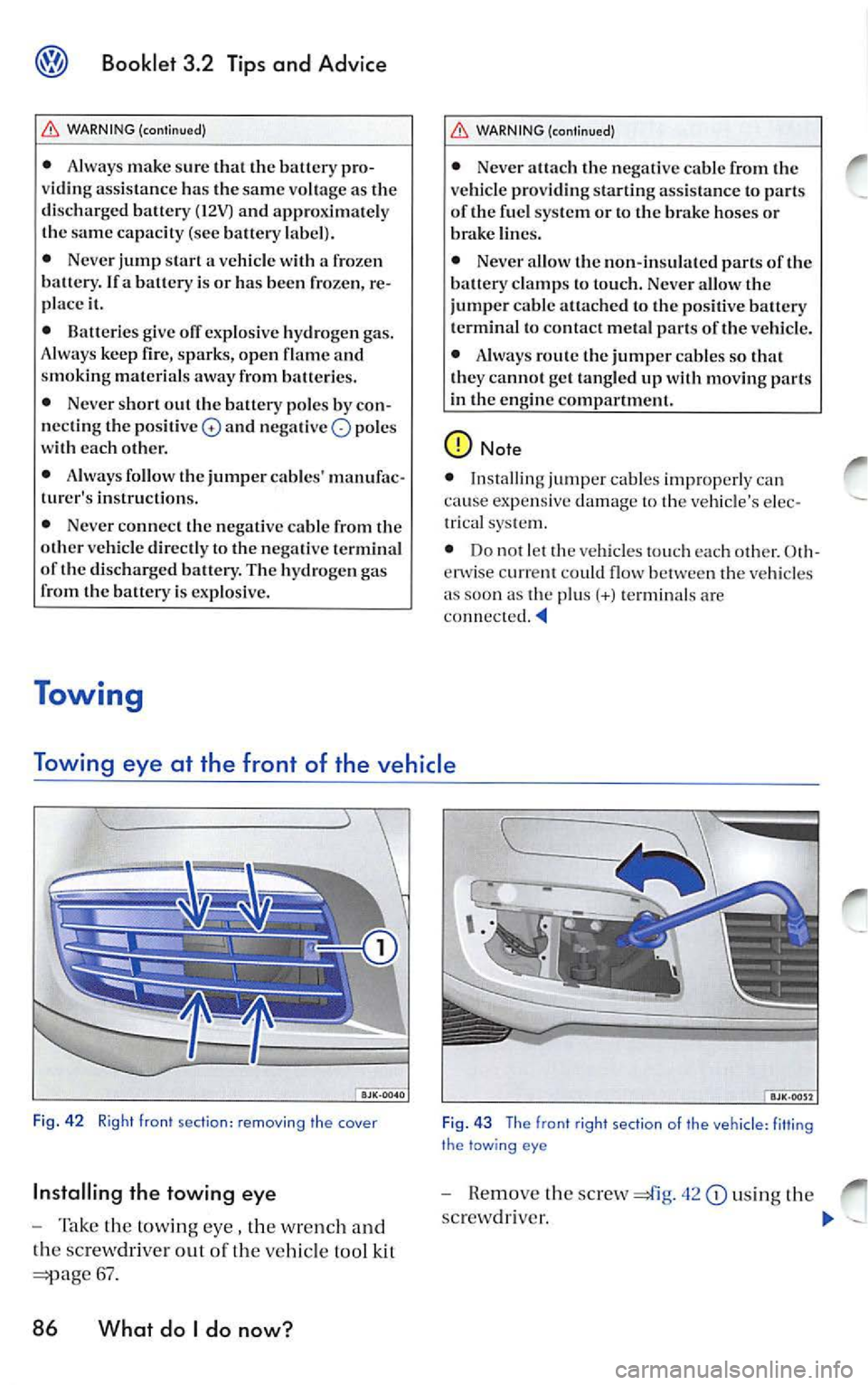
Booklet 3.2 Tips and Advice
WARNING (continued)
• Always make sure that the battery pro
v idin g ass istance has the same vo ltage as the
discharged battery (12V) and approximately
the same ca pacity (see battery label).
• Neve r jump start a ve hicle with
rrozen
batt ery. 1r a battery is or has been frozen, re
pla ce it.
• Batteries giv e
explosive hydrogen gas.
A lways keep sparks, open flame and
smoking materials away from batteri es.
• Never short out the battery pole s by con
necting the positive
and nega tive po les
with eac h other .
• Always follow the jumper cab les ' manufac
turer's instruct ions.
• Never co nn ect the negati ve cab le from the
other vehicle directly to the negat ive terminal
or the discharged battery. The hydrogen gas
rrom the battery is exp losive.
Towing
WARN ING (continued)
• Never attac h the negative cable from the
ve hicl e providing starting assistance to parts
of the fuel syst em or to the brake hoses o r
brake lines.
• Never a llow the non -in sula ted parts of th e
batt ery clamps to touch. Never allow the
jumpe r cab le a ttached to the positive battery
t ermina l to contac t metal parts of the vehicle.
• Alw ays route the jumper cables so that
th ey can not ge t tangled up with moving parts
in th e engi ne c ompartment.
the vehicl e's e lec
tri cal sys te m.
• Do not l et
veh icles touch eac h oth er. Oth
e rw ise curr ent could fl ow betwee n the ve hicles
a s soo n as the plu s(+) te rminal s are
co nn ect ed.
67.
86 What do I do now?
Fig. 43 The front right secti on of the vehicle: fitti ng
t he towing eye
- Rem ove the scre w 42 usin g the
sc rew dri ver.